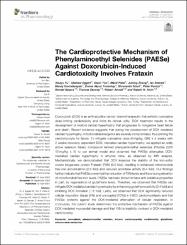| dc.contributor.author | Fu, Xiaoyu | |
| dc.contributor.author | Eggert, Mathew | |
| dc.contributor.author | Yoo, Sieun | |
| dc.contributor.author | Patel, Nikhi | |
| dc.contributor.author | Zhong, Juming | |
| dc.contributor.author | Steinke, Ian | |
| dc.contributor.author | Govindarajulu, Manoj | |
| dc.contributor.author | Turumtay, Emine Akyüz | |
| dc.contributor.author | Mouli, Shravanthi | |
| dc.contributor.author | Panizzi, Peter | |
| dc.contributor.author | Beyers, Ronald | |
| dc.contributor.author | Denney, Thomas | |
| dc.contributor.author | Arnold, Robert | |
| dc.contributor.author | Amin, Rajesh H. | |
| dc.date.accessioned | 2022-09-12T07:09:08Z | |
| dc.date.available | 2022-09-12T07:09:08Z | |
| dc.date.issued | 2021 | en_US |
| dc.identifier.citation | Fu, X., Eggert, M., Yoo, S., Patel, N., Zhong, J., Steinke, I., Govindarajulu, M., Turumtay, E. A., Mouli, S., Panizzi, P., Beyers, R., Denney, T., Arnold, R., & Amin, R. H. (2021). The Cardioprotective Mechanism of Phenylaminoethyl Selenides (PAESe) Against Doxorubicin-Induced Cardiotoxicity Involves Frataxin. Frontiers in pharmacology, 11, 574656. https://doi.org/10.3389/fphar.2020.574656 | en_US |
| dc.identifier.issn | 1663-9812 | |
| dc.identifier.uri | https://doi.org/10.3389/fphar.2020.574656 | |
| dc.identifier.uri | https://hdl.handle.net/11436/6431 | |
| dc.description.abstract | Doxorubicin (DOX) is an anthracycline cancer chemotherapeutic that exhibits cumulative dose-limiting cardiotoxicity and limits its clinical utility. DOX treatment results in the development of morbid cardiac hypertrophy that progresses to congestive heart failure and death. Recent evidence suggests that during the development of DOX mediated cardiac hypertrophy, mitochondrial energetics are severely compromised, thus priming the cardiomyocyte for failure. To mitigate cumulative dose (5 mg/kg, QIW x 4 weeks with 2 weeks recovery) dependent DOX, mediated cardiac hypertrophy, we applied an orally active selenium based compound termed phenylaminoethyl selenides (PAESe) (QIW 10 mg/kg x 5) to our animal model and observed that PAESe attenuates DOX-mediated cardiac hypertrophy in athymic mice, as observed by MRI analysis. Mechanistically, we demonstrated that DOX impedes the stability of the iron-sulfur cluster biogenesis protein Frataxin (FXN) (0.5 fold), resulting in enhanced mitochondrial free iron accumulation (2.5 fold) and reduced aconitase activity (0.4 fold). Our findings further indicate that PAESe prevented the reduction of FXN levels and the ensuing elevation of mitochondrial free iron levels. PAESe has been shown to have anti-oxidative properties in part, by regeneration of glutathione levels. Therefore, we observed that PAESe can mitigate DOX mediated cardiac hypertrophy by enhancing glutathione activity (0.4 fold) and inhibiting ROS formation (1.8 fold). Lastly, we observed that DOX significantly reduced cellular respiration (basal (5%) and uncoupled (10%)) in H9C2 cardiomyoblasts and that PAESe protects against the DOX-mediated attenuation of cellular respiration. In conclusion, the current study determined the protective mechanism of PAESe against DOX mediated myocardial damage and that FXN is implicitly involved in DOX-mediated cardiotoxicity. | en_US |
| dc.language.iso | eng | en_US |
| dc.publisher | Frontiers Media | en_US |
| dc.rights | info:eu-repo/semantics/openAccess | en_US |
| dc.subject | Doxorubicin | en_US |
| dc.subject | Phenylaminoethyl selenides | en_US |
| dc.subject | Frataxin | en_US |
| dc.subject | Cardiomyopathy | en_US |
| dc.subject | Cardiotoxicity | en_US |
| dc.subject | Glutathione | en_US |
| dc.subject | Mitochondrial metabolism | en_US |
| dc.title | The cardioprotective mechanism of phenylaminoethyl selenides (PAESe) against doxorubicin-Induced cardiotoxicity involves frataxin | en_US |
| dc.type | article | en_US |
| dc.contributor.department | RTEÜ, Fen - Edebiyat Fakültesi, Kimya Bölümü | en_US |
| dc.contributor.institutionauthor | Turumtay, Emine Akyüz | |
| dc.identifier.doi | 10.3389/fphar.2020.574656 | |
| dc.identifier.volume | 11 | en_US |
| dc.identifier.startpage | 574656 | en_US |
| dc.relation.journal | Frontiers in Pharmacology | en_US |
| dc.relation.publicationcategory | Makale - Uluslararası Hakemli Dergi - Kurum Öğretim Elemanı | en_US |


















